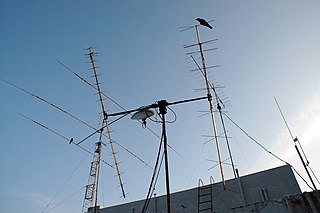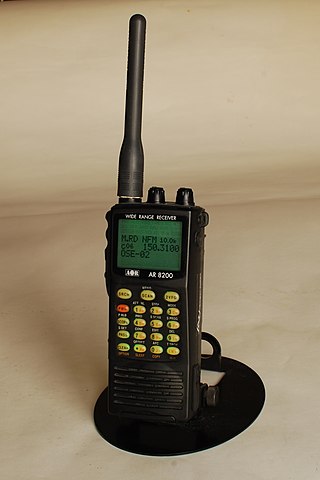
In digital radio, packet radio is the application of packet switching techniques to digital radio communications. Packet radio uses a packet switching protocol as opposed to circuit switching or message switching protocols to transmit digital data via a radio communication link.

Radioteletype (RTTY) is a telecommunications system consisting originally of two or more electromechanical teleprinters in different locations connected by radio rather than a wired link. Radioteletype evolved from earlier landline teleprinter operations that began in the mid-1800s. The US Navy Department successfully tested printing telegraphy between an airplane and ground radio station in 1922. Later that year, the Radio Corporation of America successfully tested printing telegraphy via their Chatham, Massachusetts, radio station to the R.M.S. Majestic. Commercial RTTY systems were in active service between San Francisco and Honolulu as early as April 1932 and between San Francisco and New York City by 1934. The US military used radioteletype in the 1930s and expanded this usage during World War II. From the 1980s, teleprinters were replaced by personal computers (PCs) running software to emulate teleprinters.

A pirate radio station is a radio station that broadcasts without a valid license.

Yaesu is a Japanese brand of amateur radio equipment, founded as Yaesu Musen Co., Ltd. in 1959 by a Japanese radio amateur Sako Hasegawa in Yaesu, Japan, a district of Tokyo.

Rockwell Collins was a multinational corporation headquartered in Cedar Rapids, Iowa, providing avionics and information technology systems and services to government agencies and aircraft manufacturers. It was formed when the Collins Radio Company, facing financial difficulties, was purchased by Rockwell International in 1973. In 2001, the avionics division of Rockwell International was spun off to form the current Rockwell Collins, Inc., retaining its name.

The 1.25-meter, 220 MHz or 222 MHz band is a portion of the VHF radio spectrum internationally allocated for amateur radio use on a primary basis in ITU Region 2, and it comprises frequencies from 220 MHz to 225 MHz. In the United States and Canada, the band is available on a primary basis from 222 to 225 MHz, with the addition of 219 to 220 MHz on a limited, secondary basis. It is not available for use in ITU Region 1 or ITU Region 3. The license privileges of amateur radio operators include the use of frequencies within this band, which is primarily used for local communications.

Icom Inc. is a Japanese manufacturer of radio transmitting and receiving equipment, founded in 1954 by Tokuzo Inoue with the company's original name being "Inoue". Its products now include equipment for radio amateurs, pilots, maritime applications, land mobile professional applications and radio scanner enthusiasts.
The 33-centimeter or 900 MHz band is a portion of the UHF radio spectrum internationally allocated to amateur radio on a secondary basis. It ranges from 902 to 928 MHz and is unique to ITU Region 2 (Americas). It is primarily used for very local communications as opposed to bands lower in frequency. However, very high antennas with high gain have shown 33 centimeters can provide good long-range communications almost equal to systems on lower frequencies such as the 70 centimeter band. The band is also used by industrial, scientific, and medical (ISM) equipment, as well as low-powered unlicensed devices. Amateur stations must accept harmful interference caused by ISM users but may receive protection from unlicensed devices.

Kenwood is a Japanese brand of consumer electronics. It has been owned by JVCKenwood since October 2011, when Kenwood Corporation merged with JVC. Kenwood manufactures audio equipment such as AM/FM stereo receivers, cassette tape decks/recorders, amateur radio (ham) equipment, radios, cellular phones, speakers, and other consumer electronics.

A Hamfest is a convention of amateur radio enthusiasts, often combining a trade show, flea market, and various other activities of interest to amateur radio operators (hams). In the United Kingdom the term rally is more commonly used for amateur radio conventions. "Hamfests" were noted as early as 1924 in the U.S.

An antenna rotator is a device used to change the orientation, within the horizontal plane, of a directional antenna. Most antenna rotators have two parts, the rotator unit and the controller. The controller is normally placed near the equipment which the antenna is connected to, while the rotator is mounted on the antenna mast directly below the antenna.
CUTE-1.7 + APD or CO-56 (Cubesat-Oscar-56) or just OSCAR 56 was an amateur radio satellite in the form of a double CubeSat. The satellite used commercial off-the-shelf components extensively, in particular, it used the Hitachi NPD-20JWL PDA as a control computer, and it used a USB hub for sensor communications. At the end of its mission, the satellite was supposed to deploy an electrodynamic tether to help it deorbit. The satellite failed early into its mission, so the electrodynamic tether experiment probably did not happen. It was launched on February 21, 2006 on board a Japanese launcher M-V.
The Japan Amateur Radio League (JARL) is a national non-profit organization for amateur radio enthusiasts in Japan. JARL was founded in 1926 by Japanese radio communication enthusiasts whose stated aim was to promote the development and utilization of radio wave technology as a medium. JARL says its current membership comprises the largest number of radio stations in the world, and credits its growth to "the devoted efforts of pioneering hams, who took the history of amateur radio to heart and guided it through the changing and challenging winds of technology and radio regulations". JARL is the national member society representing Japan in the International Amateur Radio Union.

Vintage amateur radio is a subset of amateur radio hobby where enthusiasts collect, restore, preserve, build, and operate amateur radio equipment from bygone years, such as those using vacuum tube technology. Popular modes of operation include speaking over amplitude modulation (AM), and communicating using Morse code through continuous wave (CW) radiotelegraphy. Some enthusiasts have interest in owning, restoring and operating vintage military and commercial radio equipment such as those from 1940s to 1960s. Some undertake to construct their own gear, known in ham slang as homebrewing, using vintage parts and designs. A number of amateur radio clubs and organizations sponsor contests, events, and swap meets that cater to this specialized aspect of the hobby.

AOR, Ltd. is a Japanese based manufacturer of radio equipment, including transceivers, scanners, antennas and frequency monitors.

GRE was a Japan-based multinational manufacturer of electronics equipment, primarily in the fields of radio and other telecommunications. Their products included transceivers, radio scanners, antennas, GPS devices, and satellite equipment. They also produced OEM equipment for other companies, including Radio Shack, Uniden and Commtel.

Japan Radio Co., Ltd. is a Japanese company specialising in the field of wireless electronics for the communications industry.
Homebrew is an amateur radio slang term for home-built, noncommercial radio equipment. Design and construction of equipment from first principles is valued by amateur radio hobbyists, known as "hams", for educational value, and to allow experimentation and development of techniques or levels of performance not readily available as commercial products. Some items can be home-brewed at similar or lower cost than purchased equivalents.

Founded in 2000 by Jim Weidner, K2JXW, the Amateur Radio Lighthouse Society (ARLHS) is devoted to maritime communications, amateur radio, lighthouses, and lightships. Its members travel to lighthouses around the world where they operate amateur radio equipment at or near the light. Collecting lighthouse QSLs is popular for some amateur radio operators. ARLHS is a membership organization with over 1665 members worldwide as of July 2009.

Amateur radio, also known as ham radio, is the use of the radio frequency spectrum for purposes of non-commercial exchange of messages, wireless experimentation, self-training, private recreation, radiosport, contesting, and emergency communications. The term "amateur" is used to specify "a duly authorized person interested in radioelectric practice with a purely personal aim and without pecuniary interest"; and to differentiate it from commercial broadcasting, public safety, or professional two-way radio services.
















